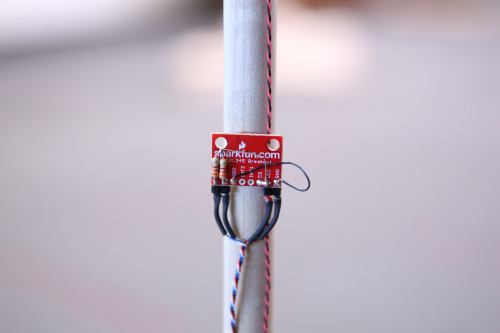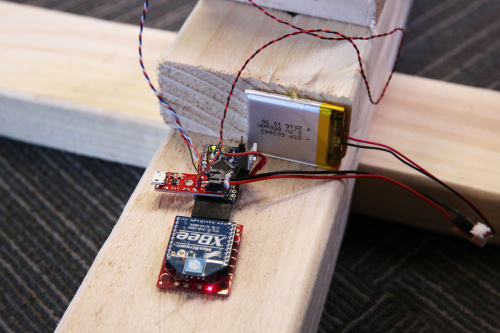I'm a big fan of weird games. A lot of the projects I've done for SparkFun involve play: the Quad Buddy Ball Balancer (which never did get a proper blog post), the FreeStick, the Hot Seat and the Pi Retrocade Cabinet.
For this week's Enginursday project, I wanted to make a fun game that involves some real movement. A friend mentioned a project she had been asked to think about that sounded so fun I had to make it. Thus was born the Fence-a-Mole, so named because it combines elements of fencing and Whack-a-Mole.
The video above shows the actual game play, but I'd like to talk a little bit about what makes the game tick. I'd also like to send a shout-out to Nick, who built the lightsaber I use in the video with our new Spectacle platform a few weeks ago.
There are five "nodes" in the game: four posts and one controller. The controller is a PC (or Raspberry Pi, if you like) running a Python script. It gives the order to a particular post to start a timing cycle (i.e., turn on the light and start counting the time until impact).
Each post has an Arduino Pro Mini, an XBee and an ADXL345 accelerometer.
The accelerometer is attached to the striking post and has the "tap detection" feature enabled. It turns out that the tap detection feature is able to very accurately differentiate between the post being struck and the post bouncing around after a strike.
The communications for the system is done via XBee. This presented some interesting challenges, as all nodes see all communications and must ignore what is not for them. To make matters worse, there are occasionally dropped characters. To overcome this, I had to implement a resend protocol where a sender looks for a receive character, and I also had to implement a check-summing system for multicharacter messages.
I don't really consider this project "finished," because I want to make a nice, visual front-end for use with a Raspberry Pi touchscreen. That's outside of my normal skillset, though, so I wasn't able to get it finished in time for this post. Oh well!
If you want more information on how this works, check out the GitHub repository for the project! There, you'll find the current code (which works, mostly).
Update: The GitHub link is broken (as of 7/22/2019). Unfortunately, we have been unable to track the repository down, but we will leave it up in case it is just a glitch and it "pops back up".
And please share your thoughts in the comments below!








For this short a range, I can't help thinking that the RFM69s (or comparable) would have been much more savvy. (I'd will in general abstain from utilizing WiFi, as it may get startling idleness on the off chance that somebody were doing a "substantial exchange" close by.)
Do you still have the code for this project? The link appears to be broken... :*(
Sorry, I am not sure where the repository disappeared to. It might have been deleted for some reason, but we haven't made any changes to the repository that we know of. I also tried to track down Mike's (guy in the video) GitHub user changes and that repository doesn't show up anywhere near the time of this blog post.
I built a game similar to this for a Tennis tournament, had to hit tennis balls at street signs made of Alupanel. Used Piezo's to detect knocks. Biggest difficulty was when one sign triggered the next, so I used a timeout to wait for the initial blow to stop resonating. A 500ms timeout seemed to work. Interesting to see how other people tackle the issue.
I could see this as a computer confirmation and timing in slalom skiing. See which posts were missed, and timing in sections and overall.
I don't understand... where was the blindfold?
Looks like a fun game.
For about the same price you could have used Raspberry Pis with built-in wifi. The built-in Linux network stack would have let you use UDP or TCP sockets for communications and you wouldn't have had to spend the time designing, implementing and debugging node addressing, retries, checksums, multi-byte packets, etc. You may have been able to finish the visual front end. Simple is the enemy of easy.
BTW, if you use a node-js server to implement a web GUI for your front end, then any device that has a browser - PC, Pi, phone, etc. - can be used as your front end hardware.
But still a fun game. maybe I'll put together the Pi version at home. Thanks for the idea.